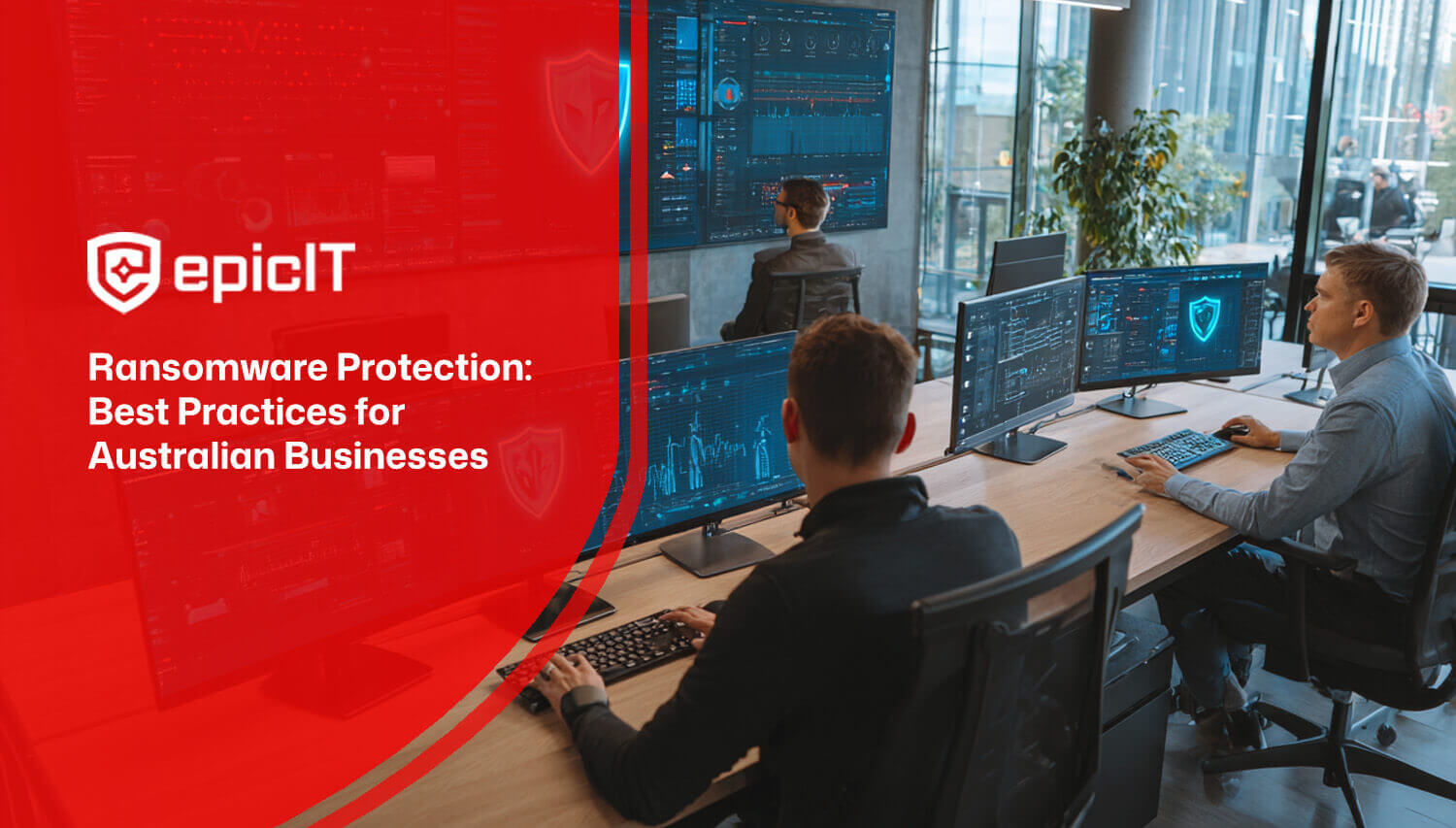
Ransomware attacks have become one of the most severe cybersecurity threats facing businesses in Australia today. These attacks are a type of malicious software that encrypts your files or locks systems, demanding payment—often in cryptocurrency like bitcoin—to regain access. A successful ransomware attack can halt business operations, compromise important files, and expose sensitive data.
For Australian businesses, understanding how to protect against ransomware is no longer optional—it’s essential. Epic IT, a leading provider of IT support and cybersecurity solutions, offers a comprehensive approach to safeguard organisations from these attacks, ensuring both data security and business continuity.

Ransomware is a type of malware designed to block access to your important files or entire systems until a ransom is paid. The most common ransomware infections are delivered through phishing emails, malicious attachments in Microsoft Office documents, unpatched vulnerabilities in Windows 10 or remote desktop services, and exposed network connections.
Some well-known ransomware threats, like WannaCry ransomware, highlighted how quickly a single ransomware infection can spread across devices on the network, encrypting files and potentially shutting down entire organisations. Once files are encrypted, paying the ransom does not guarantee that cybercriminals will provide decryption tools or that your files will be fully restored.

Microsoft Copilot offers an AI-driven approach to help businesses streamline workflows and improve cybersecurity. By providing real-time alerts and detecting potential vulnerabilities in Microsoft Office documents, Copilot can help prevent ransomware attacks before they occur.
Beyond security, Copilot helps improve efficiency by assisting employees in managing tasks without introducing risky shortcuts that could expose systems to malware. This dual approach—security and productivity—makes it a valuable tool for businesses that rely heavily on digital infrastructure.
Preventing ransomware requires a layered approach. There is no single solution that guarantees complete protection, but combining multiple strategies significantly reduces risk.
Deploying a reputable antivirus product is one of the most fundamental steps in ransomware protection. Anti-malware software can detect known malware, ransomware threats, and suspicious behaviour in real time.
Trend Micro and other premium security suites offer advanced malware protection specifically designed to detect ransomware before it encrypts files. Regularly updating antivirus products ensures your systems remain protected against the latest ransomware variants and other malicious software.
Many ransomware infections exploit outdated software or vulnerabilities in operating systems like Windows 10. Keeping software, security updates, and patches up-to-date closes these vulnerabilities and reduces the chances of a successful ransomware attack.
This includes updates not only to the operating system but also to Microsoft Office, remote desktop applications, virtual machines, and other software used by your organisation. Cybercriminals often target exposed services or older versions of applications to gain unauthorised access.
Backing up important files is essential for ransomware protection. Organisations should implement automated backup solutions that store copies of files locally, on virtual machines, or in cloud services like OneDrive.
Maintaining encrypted copies of backups ensures that ransomware cannot compromise them. Cloud backup and remote storage solutions offer additional protection against ransomware that targets local folders and network-connected drives.
A significant portion of ransomware attacks start with phishing emails or social engineering tactics. Employees who recognise suspicious emails, attachments, and links can prevent malware from entering the system.
Regular cybersecurity awareness training ensures that staff understand the risks of ransomware, the importance of not opening unknown attachments, and the dangers of clicking on malicious links. Promoting strong passwords and multi-factor authentication is also critical.
Access management limits the exposure of sensitive files and systems. Role-based access control ensures that only authorised personnel can access important documents. Combining this with multi-factor authentication creates an additional layer of protection against ransomware infections and unauthorised access.
Windows security includes controlled folder access, which protects sensitive folders from unauthorised changes by ransomware. Combining this with encryption tools ensures that even if files are accessed, they cannot be easily exploited.
Ransomware may enter via exposed services or open network connections. Regular network monitoring and scanning help detect suspicious activity, including unusual file encryption patterns or attempted access to encrypted files.
In some cases, ransomware infections can be partially remediated using known decryption tools. Security suites and anti-malware providers often maintain updated tools for popular ransomware variants like WannaCry. Prompt detection and rapid response are key to minimising damage.
Epic IT offers a range of services specifically designed to protect businesses from ransomware attacks:

Ransomware attacks are a growing threat to businesses of all sizes in Australia. From encrypting important files to demanding bitcoin payments, cybercriminals are becoming increasingly sophisticated. Implementing a multi-layered cybersecurity strategy—including antivirus and anti-malware solutions, system updates, regular backups, employee training, access controls, and advanced tools like Microsoft Copilot—is essential.
Partnering with Epic IT ensures your business is equipped with professional ransomware protection, allowing you to focus on operations while experts manage security. Protecting against ransomware is not just about responding to attacks; it’s about preventing them and maintaining business continuity in the face of evolving cyber threats.
Implementing antivirus software, security updates, employee education, multi-factor authentication, and regular backups are the most effective ways to prevent ransomware attacks.
Epic IT provides security audits, managed IT services, cloud backup systems, decryption tools, and employee training programs to help businesses prevent ransomware infections and ensure business continuity.
Yes. Regular backups—stored locally, on virtual machines, and in cloud services—allow businesses to regain access to important files even if ransomware encrypts primary data.
Multi-factor authentication adds an additional layer of security, making it difficult for cybercriminals to access sensitive systems and preventing unauthorised ransomware infections.